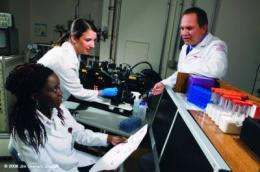Single vaccines to protect against both rabies and Ebola

Researchers from Thomas Jefferson University, among other institutions, including the National Institute of Allergy and Infectious Diseases, have developed single vaccines to protest against both rabies and the Ebola virus.
Successfully tested in mice, these bivalent vaccines have several advantages over other Ebola candidates that could help speed up development for use in humans and primates. It's built on the same platform as the already approved and financially viable rabies vaccine, and it protects at-risk populations against two viruses, not just one, making it an effective and ideal public health tool.
"Many Ebola vaccine candidates have been proven effective, but none are close to licensure," said Matthias Schnell, Ph.D., director of the Jefferson Vaccine Center. "One of the challenges is the market: There's rather limited incentive in creating a vaccine for Ebola. But these vaccines could change that."
The findings were published ahead of print online August 17 in the Journal of Virology.
The Ebola virus belongs to the Filoviridae family and is comprised of five distinct species. The Zaïre, Sudan and Bundibugyo species have been associated with large Ebola hemorrhagic fever outbreaks in Africa. According to the World Health Organization, more than a thousand people have died from the virus since it was discovered in 1976.
"Many Ebola vaccine candidates have been proven effective, but none are close to licensure," said Matthias Schnell, Ph.D., director of the Jefferson Vaccine Center. "One of the challenges is the market: There's rather limited incentive in creating a vaccine for Ebola. But these vaccines could change that."
The purpose of this study was to identify novel vaccine candidates for Ebola with a maximum potential of licensure and utilization.
Researchers generated a chemically inactivated and live rabies virus expressing the Ebola Zaïre species glycoprotein using a reverse genetics system based on the commonly-used rabies vaccine. Immunizations with those vaccines, the researchers found, induced immunity against each virus and conferred protection from both viruses in mice.
Piggy backing, in a sense, on the rabies vaccine could accelerate development of vaccines that protects against Ebola because of the advanced state of the rabies vaccine's safety, production and distribution, according to Schnell.
"After the vaccine has been tested in primates and eventually humans, this new vaccine could kill the proverbially two birds with one stone," he said.
There are implications for nonhumans, too—gorillas, in particular. The Ebola virus has eradicated thousands of gorillas, prompting the World Conservation Union to raise their status to "critically endangered" in 2007, the first time a mammal has become critically endangered as a direct result of disease. Vaccinations, though challenging, could stall those deaths.
What's more, several human outbreaks have been attributed to primate interaction or handling, so providing a vaccine for our closest relative could minimize that risk.















